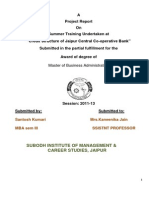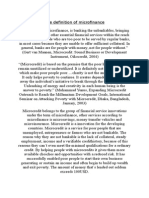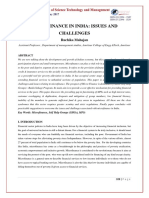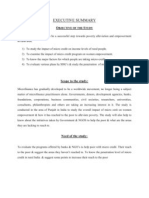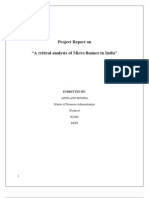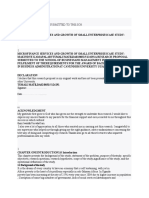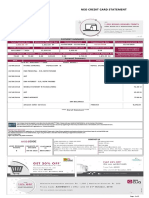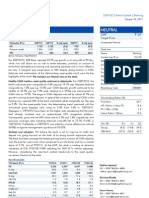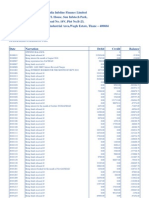Does Micro Finance Benefit The Poor
Does Micro Finance Benefit The Poor
Uploaded by
WameneCopyright:
Available Formats
Does Micro Finance Benefit The Poor
Does Micro Finance Benefit The Poor
Uploaded by
WameneOriginal Title
Copyright
Available Formats
Share this document
Did you find this document useful?
Is this content inappropriate?
Copyright:
Available Formats
Does Micro Finance Benefit The Poor
Does Micro Finance Benefit The Poor
Uploaded by
WameneCopyright:
Available Formats
The views expressed in this paper are those of the author and do not necessarily reflect the views
or policies of the
Asian Development Bank. The Asian Development Bank does not guarantee the accuracy of the data presented.
Does Micro-finance Really Benefit the Poor?
Evidence from Bangladesh
SHAHID KHANDKER
Shahid Khandker is a senior economist in the Rural Development Group, Research Department of the World Bank. This paper
is to be delivered at the Asia and Pacific Forum on Poverty: Reforming Policies and Institutions for Poverty Reduction,
to be held at the Asian Development Bank, Manila, 5-9 February 2001. The paper is based on the authors past research
and an ongoing research project on micro-finance with Mark Pitt of Brown University and M.Abdul Latif, Binayak Sen and
others from Bangladesh Institute of Development Studies. The author would like to express his thanks to Mark Pitt for
comments and suggestions, and to Nidhiya Menon and Hussain Samad for excellent research assistance. Views expressed
in this paper are entirely his and do not reflect those of the World Bank or its affiliated organizations, nor of his research
collaborators.
Asia and Pacific Forum on Poverty
S. KHANDKER ... Does Micro-finance Really Benefit the Poor? 1
I. Introduction
Micro-finance means transactions in small amounts of both credit and saving, involving
mainly small-scale and medium-scale businesses and producers. The poor, who cannot
run a small business because they lack capital, may also benefit from micro-finance
organization. The poor, especially poor women, are the prime reason for micro-finance
intervention in many countries, including Bangladesh. The question of whether micro-
finance really benefits the poor depends on how we define poverty and what kind of
help micro-finance offers to the poor to combat poverty. The face of poverty varies from
country to country.
Poverty may mean a lack of some or all of the following:
(i) Entitlement to food and other basic necessities.
(ii) Access to public provision of economic, social, and human infrastructures.
(iii) Credit, opportunities for income generation, and consumption stabilization.
(iv) Empowerment in both private and public resource allocations.
(vi) Access to a social safety net and other resources that help households
withstand natural and other shocks, thus safeguarding the very existence of life
and families.1
Given such a multifaceted definition of poverty, it is clear that what micro-
finance can do for the poor depends on the poor’s ability to utilize what micro-finance
offers them. In many countries, micro-finance provides a window of opportunity for the
poor to access a borrowing and saving facility. In other countries, these facilities also
provide organizational help, training, safety nets, empowerment, and financial and
other help during crises. Micro-finance organizations can alleviate liquidity constraints,
stabilize consumption, and enhance both income and consumption for the poor,
thereby augmenting the poor’s welfare. Borrowing from a micro-finance facility to run a
business is a self-help activity. Moreover, micro-finance satisfies the derived demand
for capital in the resource-poor households. Success in such a business depends on
skill and entrepreneurship, as well as local economic conditions. Many poor participants
may lack such skills and may benefit very little from micro-finance. On the other hand,
1. For broader definition of poverty, see World Bank (2001).
Asia and Pacific Forum on Poverty
S. KHANDKER ... Does Micro-finance Really Benefit the Poor? 2
since a lack of economic growth is the cause of poverty in many economies, the
success of micro-finance borrowers is very much limited by their local economies.
Since micro-finance transactions with the poor are very small, the accrued
benefits from micro-finance may also be small. In such a case, the important policy
question is whether micro-finance is indeed a “real” help to the poor.2 To understand
whether micro-finance really benefits the poor, we must understand who participates in
micro-finance programs, how the participants can benefit from these organizations, and
whether such benefits are sustainable. When there is not much growth in an economy,
borrowing can redistribute income. Micro-finance may help the poor through income
redistribution, but benefits accrued to participants are unsustainable through income
redistribution alone.
Income redistribution also requires net income generation in the economy.
Therefore, we must know whether micro-finance helps sustain borrowers' accrued
benefits. To know this, we must assess both the participant-level and aggregate-level
impacts of micro-finance on both the short-term and the long-term welfare indicators in
an economy. Income, consumption, and employment impacts are the immediate effects
of micro-finance interventions. Assessing program impacts on such outcomes is
necessary, in order to establish whether micro-finance helps the participants. However,
it is difficult to establish whether micro-finance really helps the poor participants. Micro-
finance’s impacts are made through borrowing, without assessing the borrower-level
net worth and other long-term welfare impacts of micro-finance. Similarly, in order to
assess whether micro-finance impacts are substantial and go beyond the program
participants, we need to assess the impacts on aggregate welfare, both in the short
term and long term.
In this paper, I address both issues. First, I identify the participants of a micro-
finance program and their characteristics. Are the poor being attracted to such
programs? The poverty of a household can be characterized by two general factors in
many countries: physical and human capital endowments. A person is poor because he
or she is poor in physical and human capital resources.3 Thus, I differentiate program
participation by these two factors of poverty.
2. According to some critics of the micro-finance programs, who see this as a failure, argue that it cannot be an
effective tool for helping the poorest people (Adams and von Pischke 1992). Some impact studies seem to support
their opinion (e.g, Coleman 1999).
3. Of course, these are two proximate factors of poverty that are easier to measure.
Asia and Pacific Forum on Poverty
S. KHANDKER ... Does Micro-finance Really Benefit the Poor? 3
Second, I assess the impacts of micro-finance on short-term and long-term
welfare indicators of program participants, as well as all participants in a local economy.
As mentioned earlier, micro-finance, because of its impact on savings and liquidity
constraint, levels out consumption and encourages investment in riskier but higher-
return activities. The immediate effects on consumption and investment do not
guarantee sustainable benefits, given the nature of self-employed and low-return
business activities of the poor. Measurement of the long-tem impacts of programs is
thus necessary to determine whether the program really helps the participants. The
third aspect, measuring aggregate impacts of micro-finance, determines whether the
program benefits others in addition to program participants.
Bangladesh is the pioneer of the micro-finance movement and the home of
large-scale micro-finance operations. Using household survey data from Bangladesh, I
assess the question of whether micro-finance really benefits the poor.
II. What We Know about Micro-finance in Bangladesh
Unlike their formal counterpart, micro-finance organizations in Bangladesh have made
great strides in delivering financial services (savings and credit) to the poor, especially
women, at a low loan default cost. Strategies such as collateral-free, group-based
lending and mobilization of savings (even in small amounts) has mitigated their formal
counterpart’s problems of poor outreach and high loan default costs. But the apparent
success has caused Bangladeshi micro-finance organizations to bear high transaction
costs, in order to keep credit discipline under group pressure and monitor borrowers’
behavior. The transaction costs are substantial, and programs rely on donors to sustain
their operations (Khandker 1998; Khalily, Imam, and Khan 2000; Morduch 1999; Yaron
1992, 1994). Nonetheless, governments and donors continue to support micro-finance
programs in Bangladesh, expecting that such investments will benefit society.
Micro-finance programs support production and consumption by the poor. Easy
loan repayment terms level out consumption and help the unemployed to become self-
employed. Donor resources may assist in building community roads, schools, or health
facilities. There are several ways to assist the poor with the resources used in micro-
finance program operations. For governments and donors, the issue is clear: If micro-
Asia and Pacific Forum on Poverty
S. KHANDKER ... Does Micro-finance Really Benefit the Poor? 4
finance programs did not benefit the poor in a sustainable way, then efforts to channel
donor resources into micro-finance would be misplaced.
To justify donor confidence in micro-credit programs, policymakers and program
organizers are keen to understand micro-finance’s socioeconomic impact on borrowers
and on society at large. At the household level, micro-finance programs result in two
types of impact: household and individual. Household-level impacts on income,
employment, and poverty do not reveal the intra-household distribution of the benefits
triggered by micro-finance. Intra-household impacts are thus examined to trace the
distribution of benefits among household members, especially between men and
women. Since women are disadvantaged in a society such as Bangladesh and hold the
overwhelming share of membership, the policy question is this: Do women benefit from
micro-finance and if so, how? At the societal level, the policy questions are these: Do
the programs benefit non-participants as well, or does micro-finance simply redistribute
income?
While the financial review of micro-finance programs in Bangladesh is less
promising than one would expect, the socioeconomic benefits of micro-finance
programs are substantial. Findings differ from study to study because of the underlying
impact assessment methodologies, but impact assessments indicate that these
programs help the poor, although all participants may not benefit equally. Hossain’s
early study of Grameen Bank shows how Grameen Bank has supported the poor,
especially women, in terms of employment, income generation, and social indicators
(Hossain 1988). Other Bangladesh Institute of Development Studies (BIDS) and non-
BIDS studies also indicate the beneficial aspects of micro-finance in Bangladesh
(Rahman 1996 Hashemi, Schuler, and Riley 1996; Schuler and Hashemi 1994). These
studies show a positive correlation between micro-finance and the accrued benefits of
program participation. However, these studies indicate no causality (showing whether
programs are significant in generating such benefits for the borrowers).
The most comprehensive micro-finance impact study to establish causality is a
joint BIDS and World Bank study in Bangladesh (Khandker 1998, Pitt and Khandker
1998). This body of research provides a strong indication that the programs help the
poor by leveling off consumption and by building assets and net worth. The findings
also support the claim that micro-finance programs promote the poor household’s
Asia and Pacific Forum on Poverty
S. KHANDKER ... Does Micro-finance Really Benefit the Poor? 5
investment in human capital, through schooling and the contraceptive behavior of
families. This major study also sheds light on our understanding of whether women
benefit from program participation. Findings suggest that women do acquire assets of
their own, and they exercise power in household decision-making.
On the other hand, Morduch (1998), using the same BIDS-World Bank survey
data but a different technique, finds the program estimates nonexistent or very small.
He argues that the Pitt and Khandker results are overestimates and, thus, flagship
programs such as the Grameen Bank’s do little to help the poor. Pitt (1999) shows that
Morduch (1999) applies a method to the BIDS–World Bank data set that
underestimates the program’s impacts. Pitt’s reestimation confirms that the impact
assessment of Grameen Bank’s and other programs, as shown in Pitt and Khandker
(1999)’s study, is well founded.4
The positive impacts of micro-finance programs at the borrower level are thus
tenable. Even so, the question arises: What are the long-term impacts of micro-
finance? Are the program impacts found in 1991/1992 sustainable over time? The other
question is this: If poverty reduction were possible with micro-finance at the borrower
level, what would be the impact of micro-finance on aggregate poverty? Earlier
estimates suggest that micro-finance contributes to a consumption rate of 18 percent
percent in the case of female borrowing and 11 percent in the case of male borrowing.
This impact on consumption rates is short-term and may be short-lived. There may be a
low proportion of program participants enjoying the benefits of micro-finance and its
impact on the overall economy on a sustainable basis. The World Bank study, based
on the 1991/1992 household survey, indicates that less than 5 percent of borrowers lift
themselves out of poverty each year by borrowing from a micro-finance program
(Khandker, 1998). This 5 percent of the micro-finance borrowers represents only about
1 percent of the population, which means that the aggregate poverty impact of micro-
finance program is quite negligible. Does the World Bank study imply that micro-finance
programs should be resisted? Has the end product of micro-finance improved or
deteriorated in the recent past?
Pros and cons aside, the micro-finance movement in Bangladesh received the
World Bank’s support in 1996: a US$115 million project in which the country’s
4. Those who are interested in Mark Pitt’s analysis of Morduch’s re-analysis of Pitt and Khadker (1998) results,
may see the paper in Mark’s Pitt’s website: http://pstc3.pstc.brown.edu/~mp/
Asia and Pacific Forum on Poverty
S. KHANDKER ... Does Micro-finance Really Benefit the Poor? 6
autonomous body PKSF acted as an intermediary for wholesaling micro-finance. The
project ended in June 2000 and the World Bank prepared a follow-up project of
US$160 million at the government’s request. In 1998/1999, about 8 million households
out of 30 million received help from micro-finance programs. Outstanding loans for
micro-finance programs were about US$600 million in 1998/99. The NGO sector,
including the Grameen Bank, accounted for more than 86 percent of this share, while
only 14 percent came from the country’s commercial banks.
Despite the large inflow of micro-finance, the incidence of rural poverty remains
stubbornly high. The incidence of rural poverty, which was 54 percent in 1983/84,
remained above 50 percent over the last decade (Ravallion and Sen 1995). A
government estimate indicates that poverty fell to about 44 percent recently. Although
this decrease is encouraging, the incidence of poverty remains high and reminds
policymakers of the limitations of micro-finance in arresting poverty. Is the high
incidence of poverty a failure of the micro-finance movement? Is the high incidence of
poverty a result of the persistently low economic growth rate (3-4 percent over the last
decade) in Bangladesh? Or does the high incidence of poverty justify the current
emphasis on micro-finance operations?
III. Impact Assessment Using a Panel Household Survey
The outstanding research issues are: Can micro-finance reduce poverty on a sustained
basis at the participant level, if not at the community level? Does micro-finance really
benefit those who need the most help? What are micro-finance’s long-term impacts on
household welfare? Are the estimated impacts compelling, given that impact estimates
are sensitive to impact assessment methodologies? These issues are topics in an
ongoing research project supported by the World Bank.5 In 1998/1999, researchers
from BIDS, Brown University, and the World Bank revisited the households that were
surveyed in 1991/1992.
Program impact assessments are subject to two sources of bias: (i) program
placement endogeneity and (ii) program participation endogeneity. Earlier results show
that endogeneity is a serious issue and that assessment results could be misleading if
the endogeneity/heterogeneity were overlooked by the impact assessment (Pitt and
Khandker 1998). The methodology used in the BIDS-WB study is based on cross-
Asia and Pacific Forum on Poverty
S. KHANDKER ... Does Micro-finance Really Benefit the Poor? 7
section data and uses a quasi-experimental survey design to resolve the problems of
endogeneity at the village and household levels.
The survey design has three components: (i) households are sampled in
villages with and without programs, (ii) eligible and ineligible households alike are
sampled in both types of village, and (iii) program participants and nonparticipants
within eligible households are sampled. Program impact identification has two
underlying conditions: (i) exogenous landholding and (ii) gender-based program design.
Households with less than half an acre of land are eligible—this eligibility requirement
makes the program’s impact more apparent to researchers. Additionally, researchers
identify women-only and men-only groups within villages to highlight the program
impacts by gender.
Three compelling reasons for using a repeat survey and panel data analysis are
the following:
(i) Results may otherwise be less robust, as some studies show that the
measurement of program impact depends on the treatment of program
endogeneity (Lalonde 1986). An alternative method such as the
household/individual fixed-effects method takes care of program
endogeneity, without relying on controversial assumptions.
(ii) Results may be sensitive to the land-based exclusion restriction that was
imposed in the analysis. It is important to see the robustness of the
results with a method that does not rely on the exogeneity of landholding
in identifying the program’s effects. With panel data, the fixed-effects
method is less reliant on the exact application of the landholding rule by
the micro-credit programs.
(iii) Cross-section data provides short-term program effects; however,
programs take a long time to influence outcomes such as net worth. A
panel survey analysis will measure the long-term program effects.
BIDS and the World Bank surveyed 1,798 households selected from 87 villages
in 29 thanas in 1991/1992. Eight thanas were drawn randomly from each of BRAC,
Grameen Bank, and BRDB's RD-12 project thanas. Five thanas without a micro-credit
program were also drawn randomly. Three villages were then drawn randomly from
5. Besides, the ongoing research project addresses other issues such as the role of credit versus non-credit
inputs, the role of group in group-based lending, and the role of micro-finance in empowering women.
Asia and Pacific Forum on Poverty
S. KHANDKER ... Does Micro-finance Really Benefit the Poor? 8
each thana, where the programs had operated for at least three years. The household
distribution by program participation status according to 1991/1992 survey is: (i) 8.5
percent Grameen Bank members; (ii) 11.2 percent BRAC members; (iii) 6.3 percent
RD-12 project members; (iii) 40.9 percent eligible non-participants, and (iv) 33.1 percent
nontarget households. A follow-up survey in 1998/1999 included the households from
the previous survey, new households from the same villages, new households from
new villages in old thanas, and three more thanas, increasing the number of sample
households to 2,599.
According to the 1998/1999 re-survey with 2,599 households, household
distribution by program participation status is: (i) 14.3 percent Grameen Bank members,
(ii) 9.3 percent BRAC members, (iii) 3.6 percent RD-12 project members, (iv) 11.1
percent other NGO members, (v) 7.4 percent multiple program members, (vi) 32.0
percent eligible nonparticipants, and (vii) 22.3 percent non-target households. Program
participation has increased from 26.2 percent in 1991/1992 to 45.6 percent in
1998/1999.
IV. Who Participates in a Micro-finance Program?
According to one household survey, about 34 percent of eligible households in
1991/1992, compared to 56 percent in 1998/1999, participated in micro-finance
programs in Bangladesh. The dropout rate, about 5 percent in 1991/1992, increased to
about 10 percent in 1998/1999. Net program participation among eligible households
was 29 percent in 1991/1992 and 46 percent in 1998/1999. These households must
have benefited from the programs; otherwise, the dropout rate would have been higher
and the program participation rate would not have increased.
Among program participants, not all households satisfy the eligibility criteria of
the micro-finance programs. Remarkably, however, the extent of mistargeting in micro-
finance programs of Bangladesh remains constant since 1991/1992. About 23 percent
of program borrowers came from the non-target households in 1991, compared to 25
percent in 1998/1999.
To determine who participates in a micro-finance program, assume that the
following reduced-form credit demand by women (Cijf) and men (Cijm) of ith households
in jth village of females (f) and males (m) is given by:
Asia and Pacific Forum on Poverty
S. KHANDKER ... Does Micro-finance Really Benefit the Poor? 9
Cijf = X ij β cf + µ cjf + ∈ijfc (1)
Cijm = X ij β cm + µ cjm + ∈cijm (2)
where X is a vector of household characteristics (age and education of household
head), β is a vector of unknown parameters to be estimated, µ is an unmeasured
determinant of the credit demand that is fixed within a village, and ∈ is a nonsystematic
error.
The village-level, fixed-effects estimates in the 1998/1999 survey (2,599
households) of program participation and the amount of borrowing for female and male
members are shown for two sets of households: (i) all households (Table 1) and (ii)
households who met the eligibility conditions of holding fewer than 50 decimals of land
(Table 2).6 For the regression analysis of all types of households, we find that the
households that were resource-poor, both in landholding and formal education, did
participate in micro-finance programs. A 10 percent increase in landholding reduces a
household's micro-finance participation by about 1 percent and the total amount of
borrowing by about 6 percent. Additionally, a one-year increase in female education
reduces microfinance participation by 1.5 percent. Male education also reduces micro-
finance participation. However, once a household decides to participate, male
education helps to increase the amount of borrowing. This information supports the
notion that the poor do participate in the micro-finance programs in Bangladesh.
This finding is supported further by analyzing only those households with fewer
than 50 decimals of land (Table 2). While higher female education reduces program
participation as well as borrowing for females, higher male education increases male
borrowing from micro-finance programs. In contrast, among households meeting the
landholding-based eligibility conditions, lower landholding means higher program
participation. In other words, the ultra-poor do participate in micro-finance programs. In
fact, an overwhelming percentage (80 percent) of micro-finance program participants in
Bangladesh includes households holding either zero or fewer than 20 decimals of land.
For them the most relevant question is, Do these poor micro-finance participants really
benefit from their participation?
6. The landholding is taken prior to program participation for micro-finance program members.
Asia and Pacific Forum on Poverty
S. KHANDKER ... Does Micro-finance Really Benefit the Poor? 10
V. Program Impacts on Participating Households
Both the short-term and long-term impacts of micro-finance are important for program
participants. Short-term behavior such as per capita consumption or the probability of
being above the poverty line determines whether the program makes any significant
impact in alleviating poverty among program participants. On the other hand, micro-
finance’s impact on long-term behavioral outcomes (such as household net worth)
determines whether the program’s impacts are sustainable, make headway over a
longer period of time, and allow households to accumulate assets over and above the
amount of their outstanding loans.
The conditional demand for outcomes (Yijt) (such as per capita consumption)
conditional on the level of credit demand (Cij) is
Yijt = X ijt β y + Cijftδ f + Cijmt δ m + µ jy + ∈ijty (3)
where δf and δm are the effects of female and male credit respectively.
With cross-sectional data (where t=1), the estimation issue arises as a result of
the possible correlation of µ cjf , µ cjm , and µ jy , and of ∈cij with ∈ijy (Pitt and
Khandker, 1998). To resolve this endogeneity, Pitt and Khandker used the village fixed-
effects method along with the exogenous gender and landholding-based exclusion
restrictions to estimate the impacts female and male credit. With panel data where
households have more than one observation, such complicated identification
restrictions are not required. This estimation is done by differencing out the unobserved
village and household attributes, which are the sources of correlation between the
credit demand and household outcome equations. Differencing equation (3) at two
points of time yields the following outcome equation
∆Yij = ∆X ij β y + ∆Cijf δ f + ∆Cijmδ m + ∆ ∈ijy (4)
Asia and Pacific Forum on Poverty
S. KHANDKER ... Does Micro-finance Really Benefit the Poor? 11
Consistent estimates of the credit effect δf and δm can be obtained from equation (4)
using the household fixed-effects method without recourse to instrumental variables
estimation such as the one used in the quasi-experimental survey design.
The above fixed-effects method consistently estimates credit impact. However,
if credit were measured with error, this error would be amplified when doing fixed-
effects estimation, particularly with only two time periods. This measurement error
would impart "attentuation bias" on the credit coefficients; they would be biased
towards zero. A standard correction for this bias is the use of instrumental variables (IV)
estimation. In our earlier paper (Pitt and Khandker 1998), IV method was called for
because of the endogeneity of credit and it also took care of any measurement error in
credit. In this household fixed-effects model, IV is not required because of endogeneity,
but may still be required because of measurement error. These conditions lead us to
estimate the above equation in two stages. First we regress changes in the amount of
borrowing between 1991/1992 and 1998/1999 at the 1991/1992 level of household and
village attributes, to get the predicted change in the amount of borrowing. Second, we
use the fitted credit amount in the changes in outcomes equations with the household
fixed-effects estimation.
Table 3 presents the summary statistics of all endogenous variables. Micro-
finance participants do better than non-participants in both 1991/1992 and 1998/1999,
in per capita income, per capita expenditure, and household net worth. The incidence
of poverty among participating households is lower in 1998/1999 than in 1991/1992,
and lower than among nonparticipating households in both periods.
Table 4 shows the two-stage estimates of program impacts on three short-term
outcomes: (i) per capita expenditure, (ii) per capita income, and (iii) the incidence of
poverty. Table 4 also shows the impact estimates on a long-term outcome: household
net worth. Results show that borrowing by women has a positive significant impact (at a
1 percent level of significance) on per capita expenditure, per capita income and net
worth, and a negative effect on the incidence of poverty. The response elasticity for
male borrowing is 0.05 for per capita consumption and 0.11 for net worth. In contrast,
the response elasticity for female borrowing is 0.03 for per capita consumption, and
0.06 for per capita income. A 10 percent increase in borrowing from a micro-finance
program reduces the probability of being above poverty line by 0.3 percent for male
Asia and Pacific Forum on Poverty
S. KHANDKER ... Does Micro-finance Really Benefit the Poor? 12
borrowing and by 0.2 percent for female borrowing. The results support the assertion
that programs help poor borrowers over time, and meet their immediate needs.
VI. Micro-finance Impacts on Village Welfare
There are four major programs (Grameen Bank, BRAC, ASA, and Proshika) that
account for about 65 percent of borrowers (68 percent of membership) and 72 percent
of all outstanding loans in 1998/1999. Grameen Bank accounted for one fourth of the
market share of the micro-finance industry in Bangladesh. The total loan outstanding
was about US$600 million in 1998/1999. This figure shows a large inflow of micro-
finance funds into rural Bangladesh and is expected to make an aggregate impact on
the local economy. That is, the impacts must extend beyond the program participants.
We may assess this extended impact by examining program impacts on all
households with the following equation:
Yijt = X ijt β y + C jftδ f + C jmtδ m + µ jy + ∈ijty
where Cjft and Cjmt is the village-aggregate amount of borrowing by female and male
borrowers in micro-credit programs. Unlike the earlier equation, every household in the
village in this equation receives the same female and male credit irrespective of
whether they participate in a micro-finance program. We use a village-level, fixed-
effects method to estimate the micro-finance effect on the welfare of all households in
a village.
Table 5 presents the aggregate micro-finance impact on the local economy.
One set of results includes no village-level attributes such as prices and infrastructures,
while the other set includes them. Without controlling for village-level attributes, we find
that micro-finance affects the aggregate village-level welfare indicators such as per
capita income, expenditure and net worth, but with an insignificant effect on poverty.
The effects either decrease or disappear when variations in village-level attributes are
controlled for. This trend also appears with the results for the nonparticipant
households in the economy (Table 6). Results may indicate no substantive program
impacts on village-level welfare indicators or among nonparticipating households,
Asia and Pacific Forum on Poverty
S. KHANDKER ... Does Micro-finance Really Benefit the Poor? 13
although household net worth increases with female borrowing and income increases
with male borrowing for both cases.
The decline in impact due to the inclusion of village-level variables may imply
that micro-finance has an impact on all households or nonparticipants, and via changes
in village-level attributes such as prices and wages. In order to determine whether this
correlation exists, we fit a regression by relating changes in price, wage, and other
village attributes to changes in female and male borrowing between 1991/1992 and
1998/1999, after controlling for the 1991/1992 level of prices, wages, and other village
attributes. The estimates appear in Table 7. The results show that micro-finance affects
the local economic environment through price, wage, and village accessibility, thereby
affecting the welfare of the local economy.
VII. Conclusion
Program evaluation is sensitive to the methods used in impact assessment. In our
earlier study based on cross-section data from Bangladesh, we find that programs
make a difference to the poor households who are members of Grameen Bank and
similar micro-finance programs in Bangladesh. However, the impact assessments are
subject to assumptions such as exogeneity in landholding. Moreover, we use a quasi-
experimental survey design to resolve the endogeneity of program participation. In
order to determine whether program impact measurement is sensitive to the estimation
methodology, we carry out a follow-up survey in Bangladesh. The panel household
survey helps estimate the program effects by using the household fixed-effects
method, removing the bias due to endogeneity of program placement and program
participation. Results confirm the earlier findings that programs make a difference to
poor participants by raising per capita income and consumption as well as household
net worth, thereby increasing the probability that the program participants lift
themselves out of poverty. The welfare impact of micro-finance is also positive for
participating and nonparticipating households, indicating that micro-finance programs
help the poor beyond income redistribution and income growth. The programs have
spillover effects on the local economy, but the impacts are very small.
Asia and Pacific Forum on Poverty
S. KHANDKER ... Does Micro-finance Really Benefit the Poor? 14
No matter how small the aggregate impact, micro-finance is significant in
Bangladesh for its innovations in rural credit markets and its impact of empowering the
poor, especially women. It is also well established that micro-finance programs reach
an overwhelming majority of the poor and women, to whom formal financial institutions
are inaccessible. With their expenses of outreach and loan recovery, Bangladeshi
programs find it difficult to achieve financial independence, despite their struggle to
become cost-effective through portfolio diversification and other actions. As the majority
of micro-finance clients are poor, the survival question of micro-finance is linked with
the dynamics of poverty.
Even if poverty decreases through micro-finance, albeit at a slow rate, poverty is
rampant in a country that has the largest presence of micro-finance programs in the
world. Micro-finance is not to blame for this high incidence of poverty. We must admit
that micro-finance is only an instrument among a large number of poverty reduction
strategies that policymakers must pursue to reduce poverty. Certainly growth is a
significant factor in reducing poverty. Investment in human capital and other means to
empower the poor are also important tools for reducing poverty. Similarly, micro-finance
intervention reduces poverty for a small percentage of the poor, and certainly provides
an institutional credit and savings facility to a large percentage of the poor, especially
women. The role of micro-finance must be evaluated from such perspectives.
Asia and Pacific Forum on Poverty
S. KHANDKER ... Does Micro-finance Really Benefit the Poor? 15
Table 1. Village fixed-effects estimates of credit program participation
and the amount of borrowing
Explanatory Variables Program Female Male Total
Participation Borrowing Borrowing Borrowing
(probit) (tobit) (OLS) (tobit)
Maximum education of household male -0.008 -0.001 0.023 -0.007
(years) (-1.905) (-0.171) (1.692) (-0.400)
Maximum education of household female -0.015 -0.084 -0.021 -0.109
(years) (-3.200) (-2.984) (-1.819) (-3.709)
Household land assets (decimal) -0.104 -0.139 -0.113 -0.538
(-10774.258) (-7.610) (-3.639) (-8.377)
Adjusted R squared 0.207 0.129 0.126 0.107
Observations (number of households) 1,935 1,975 1,975 1,975
Note: Complete regressions include, in addition to above variables, other household level variables.
Source: BIDS-World Bank household surveys, 1998/1999.
Table 2. Village fixed-effects estimates of credit program participation
and amount of borrowing (target households only)
Explanatory Variables Program Male Female Total
Participation Borrowing Borrowing Borrowing
(probit) (OLS) (tobit) (tobit)
Maximum education of household male -0.007 0.058 0.006 0.037
(years) (-1.312) (3.128) (0.455) (1.522)
Maximum education of household female -0.022 -0.028 -0.053 -0.106
(years) (-3.417) (-1.255) (-3.346) (-3.523)
Household land assets (decimal) -0.033 0.003 -0.093 -0.166
(-2.072) (0.060) (-2.542) (-2.351)
Adjusted R squared 0.156 0.228 0.102 0.086
Observations 1,233 1,284 1,284 1,284
Notes: Complete regressions include, in addition to above variables, other household level variables. A Tobit
model cannot be used for male borrowing because of too few right-censored observations.
Source: BIDS-World Bank household surveys, 1998/1999.
Asia and Pacific Forum on Poverty
S. KHANDKER ... Does Micro-finance Really Benefit the Poor? 16
Table 3. Summary statistics of outcome and credit variables
Explanatory Variables 1991/92 1998/99
Program Target Non- Nontarget Program Target Non- Nontarget
Participants participants group Participants participants group
Male borrowing (taka) 3,250.5 0 0 3,177.1 0 0
(7,046.1) (10,810.0)
Female borrowing (taka) 5,697.2 0 0 12,689.2 0 0
(7,993.6) (19,628.7)
Household per capita 3,979.3 3,819.1 5,867.9 5,437.9 4,534.1 7,253.3
Yearly expenditure (1,629.5) (1,731.9) (3,879.6) (4,005.0) (2,705.6) (5,874.8)
(taka)
Household per capita 4,195.4 3,735.0 4,736.1 5,193.6 4,507.6 7,501.5
Yearly income (taka) (9,382.3) (6,383.7) (7,514.8) (4,536.0) (4,520.2) (7,377.6)
Poverty head count ratio 0.900 0.896 0.665 0.703 0.778 0.515
(0.300) (0.305) (0.473) (0.457) (0.416) (0.501)
Household net worth 63,404.7 34,770.4 286,791.8 138,057.6 86,484.5 650,362.2
(taka) (92,818.2) (74,260.6) (369,510.3) (290,968.3) (248,994.3) (1,836,344.0
)
Observations 591 539 233 771 279 237
Note: Figures in parentheses are standard deviations.
Source: BIDS-World Bank household surveys, 1991/92 and 1998/99
Table 4. Fixed-effects estimates of micro-finance
on household welfare of participants
Explanatory Household per Capita Household per Poverty Household Net
Variables Yearly Expenditure Capita Yearly Headcount ratio1 Worth
Income
Male 0.053 0.032 -0.032 0.109
borrowing (3.503) (0.706) (-2.292) (3.010)
Female 0.032 0.062 -0.020 0.018
borrowing (5.158) (3.281) (-3.497) (1.176)
Adjusted R 0.029 0.003 0.078 0.345
squared
Observations 2,726 2,726 2,726 2,726
Notes: Complete regressions include, in addition to above variables, other household and village level
variables. 1Poverty headcount ratio in this and subsequent tables has been defined as the percentage of
households with per capita expenditure below the poverty line per capita expenditure defined for the
sample.
Sources: BIDS-World Bank household surveys, 1991/1992 and 199819/99.
Asia and Pacific Forum on Poverty
S. KHANDKER ... Does Micro-finance Really Benefit the Poor? 17
Table 5. Fixed-effects estimates of micro-finance on aggregate village welfare
Explanatory Household per Household per Poverty Headcount Household Net
Variables Capita Yearly Capita Yearly Ratio Worth
Expenditure Income (logit) (OLS)
(OLS) (OLS)
Model 1 Model 2 Model 1 Model 2 Model 1 Model 2 Model 1 Model 2
Male borrowing 0.0002 0.005 0.026 0.030 0.011 -0.002 0.002 0.001
(0.082) (1.725) (3.141) (3.835) (0.477) (-0.101) (0.232) (0.196)
Female borrowing 0.001 -0.004 0.008 0.005 -0.010 0.026 0.017 0.033
(0.268) (-1.280) (0.743) (0.566) (-0.348) (1.046) (1.703) (3.875)
Adjusted R 0.267 0.242 0.079 0.074 ch2(28) ch2(18)= 0.548 0.578
squared =528.77 496.21
Observations 2,726 2,726 2,726 2,726 2,726 2,726 2,726 2,726
Notes: Complete regressions include, in addition to above variables, other household and village level variables.
Model 1 includes village variables while model 2 does not.
Source: BIDS-World Bank household surveys, 1991/1992 and 1998/1999.
Table 6. Estimates of micro-finance on village prices and wages
Explanatory Household per Household per Poverty Household Net
Variables Capita Yearly Capita Yearly Headcount Ratio Worth
Expenditure Income (logit) (OLS)
(OLS) (OLS)
Model 1 Model 2 Model 1 Model 2 Model 1 Model 2 Model 1 Model 2
Male borrowing 0.0003 0.005 0.023 0.026 0.023 0.027 0.008 0.002
(0.067) (1.103) (1.647) (1.974) (0.580) (0.567) (1.048) (1.605)
Female borrowing 0.0004 -0.001 0.011 0.016 -0.011 -0.006 0.009 0.025
(0.069) (-0.249) (0.624) (1.117) (-0.226) (-0.118) (0.850) (2.947)
Adjusted R 0.408 0.357 0.091 0.056 ch2(28) ch2(18) 0.731 0.720
squared =253.44 =70.19
Observations 994 994 994 994 932 932 994 994
Note: Complete regressions include, in addition to above variables, other household and village level variables.
Model 1 includes village variables while model 2 does not.
Sources: BIDS-World Bank household surveys, 1991/1992 and 1998/1999.
Asia and Pacific Forum on Poverty
S. KHANDKER ... Does Micro-finance Really Benefit the Poor? 18
References
Adams, D.W., and J.D. Von Pischke 1992, “Microenterprise Credit Programs: Déjà vu” World
Development, 20 (October): 1463-70.
Coleman, B.E., 1999, “The Impact of group lending in Northeast Thailand” Journal of Development
Economics, 60 (October): 105-141.
Hashemi, Syed M., Sidney R. Schuler, and Ann P. Riley, 1996, “Rural Credit Programs and
Women’s Empowerment in Bangladesh” World Bank 24 (April): 635-53.
Hossain, Mahabub, 1988, “Credit for Alleviation of Rural Poverty: The Grameen Bank in
Bangladesh.” IFPRI Research Report 65, IFPRI, Washington, D.C.
Khalily, M. B., M. O. Imam, and S. A. Khan, 2000, "Efficiency and Sustainability of Formal and Quasi-
formal Micro-finance Programs-- An Analysis of Grameen Bank and ASA," The Bangladesh
Development Studies, A Special Issue on Microfinance and Development: Emerging Issues,
26 (June/September): 103-146, edited by Rushidan I. Rahman and Shahidur R. Khandker.
Khandker, Shahidur R., 1988, Fighting Poverty with Microcredit: Experience in Bangladesh, Oxford
University Press for the World Bank.
Lalonde, R., 1986, "Evaluating the Econometric Evaluations of Training Programs with Experimental
Data", American Economic Review, 76: 604-620.
Morduch, J., 1998, “Does Microfinance Really Help the Poor? New Evidence from Flagship Programs
in Bangladesh” Unpublished mimeo.
Morduch, J., 1999, “The Role of Subsidies in Microfinance: Evidence from the Grameen Bank” Journal
of Development Economics, vol. 60 (October): 229-248.
Pitt, Mark M., 1999, "Reply to Jonathan Morduch's 'Does Microfinance Really Help the Poor? New
Evidence from Flagship Programs in Bangladesh'" Unpublished Manuscript.
Pitt, Mark M. and Shahidur R. Khandker, 1998, “The Impact of Group-Based Credit Programs on
Poor Households in Bangladesh: Does the Gender of Participants Matter?” Journal of Political
Economy, 106 (October): 958-96.
Rahman, Rushidan I., 1996, “Impact of Grameen Krishi Foundation on the Socioeconomic Condition
of Rural Households,” Working paper No. 7, BIDS.
Ravallion, Martin, and Binayak Sen, 1995, “When Methods Matter: Towards a Resolution of the
Debate about Bangladesh’s Poverty Measures,” Policy working paper 1259, World Bank,
Washington, D.C.
Schuler, Sidney R., and Syed M. Hashemi, 1994, “Credit Programs, Women’s Empowerment, and
Contraceptive Use in Rural Bangladesh,” Studies Family Planning, 25 (March/April):65-76.
Yaron, Jacob, 1994, “What Makes Rural Finance Institutions Successful?” The World Bank Research
Observer 9 (1): 49-70.
Asia and Pacific Forum on Poverty
You might also like
- Proforma Invoice PT Bayu Buana Travel (7954)Document1 pageProforma Invoice PT Bayu Buana Travel (7954)Marketing Diara HotelNo ratings yet
- Role of MICRO Finance in Financial InclusionDocument16 pagesRole of MICRO Finance in Financial InclusionBharath Pavanje75% (4)
- Micro Finance and Poverty Alleviation, NurDocument17 pagesMicro Finance and Poverty Alleviation, Nurnurrhat50% (4)
- Debt Capital Markets: The Basics For IssuersDocument28 pagesDebt Capital Markets: The Basics For Issuersvinaymathew100% (1)
- DBP Vs ArcillaDocument2 pagesDBP Vs Arcillacmv mendoza100% (2)
- Microfinance and Its Impact On IndiaDocument60 pagesMicrofinance and Its Impact On Indiabagal07100% (1)
- MicrofinanceDocument65 pagesMicrofinanceRahul AksHNo ratings yet
- Chapter: - 1Document56 pagesChapter: - 1rajNo ratings yet
- MicrofinanceDocument58 pagesMicrofinanceSamuel Davis100% (1)
- Eco-Geo Assignment IDocument11 pagesEco-Geo Assignment INal ChowdhuryNo ratings yet
- Project Report On "A Critical Analysis of Micro Finance in India"Document36 pagesProject Report On "A Critical Analysis of Micro Finance in India"Sanjay ShahNo ratings yet
- Microfinance and Poverty Evidence Using Panel Data From BangladeshDocument25 pagesMicrofinance and Poverty Evidence Using Panel Data From BangladeshCharles PeterNo ratings yet
- Edited MicrofinanceDocument59 pagesEdited Microfinancedarthvader005No ratings yet
- ReductionDocument17 pagesReductionedvinabregu08No ratings yet
- A Critical Analysis of Micro Finance in IndiaDocument54 pagesA Critical Analysis of Micro Finance in IndiaArchana MehraNo ratings yet
- Thesis ProposalDocument30 pagesThesis ProposalmlachuNo ratings yet
- Ijmrd: A Study On Recent Trends and Problems in Using Micro Finance Services in IndiaDocument11 pagesIjmrd: A Study On Recent Trends and Problems in Using Micro Finance Services in IndiaRogil Jacob DanielNo ratings yet
- Report On Micro FinanceDocument54 pagesReport On Micro Financemohsinmalik07100% (1)
- Micro Finance Final WorkDocument37 pagesMicro Finance Final WorkKamrul MozahidNo ratings yet
- "Microfinance in India An Indepth Study": Project Proposal TitledDocument7 pages"Microfinance in India An Indepth Study": Project Proposal TitledAnkush AgrawalNo ratings yet
- A Study On Recent Trends and Problems in Using Micro Finance Services in India-2Document11 pagesA Study On Recent Trends and Problems in Using Micro Finance Services in India-2prjpublicationsNo ratings yet
- The Definition of MicrofinanceDocument6 pagesThe Definition of MicrofinanceAyush BhavsarNo ratings yet
- IntroductionDocument27 pagesIntroductionsagarbanavathNo ratings yet
- Poverty Alleviation Through Micro Finance in India: Empirical EvidencesDocument8 pagesPoverty Alleviation Through Micro Finance in India: Empirical EvidencesRia MakkarNo ratings yet
- CH Allen EgsDocument5 pagesCH Allen EgsY N S Y SNo ratings yet
- SHG SMP SPP Rev PaperDocument24 pagesSHG SMP SPP Rev Papersundram vatsaNo ratings yet
- Report On Micro FinanceDocument55 pagesReport On Micro FinanceSudeepti TanejaNo ratings yet
- Micro Finance ProposalDocument11 pagesMicro Finance ProposalMarah KalieNo ratings yet
- Assignment MicrofinanceDocument28 pagesAssignment MicrofinanceKamrul MozahidNo ratings yet
- A Study On Microfinance in India: ArticleDocument6 pagesA Study On Microfinance in India: ArticleShruti SrivastavaNo ratings yet
- Micro Fin AceDocument3 pagesMicro Fin AceAman AroraNo ratings yet
- Macroeconomics: The Goals of Macroeconomic PolicyDocument13 pagesMacroeconomics: The Goals of Macroeconomic Policyduarif14No ratings yet
- Chapter 8Document15 pagesChapter 8himanshNo ratings yet
- A Study On Role and Effects of Microfinance Banks in Rural Areas in India 2Document55 pagesA Study On Role and Effects of Microfinance Banks in Rural Areas in India 2Rohit KumarNo ratings yet
- A Study On Role and Effects of Microfinance Banks in Rural Areas in India 1Document63 pagesA Study On Role and Effects of Microfinance Banks in Rural Areas in India 1Rohit KumarNo ratings yet
- Ado2021bn Microfinance Social DevelopmentDocument24 pagesAdo2021bn Microfinance Social DevelopmentFlordelyn CagadasNo ratings yet
- Joint Liability Groups (JLGS) - The Saviors of Urban Poor: Padma K.M.S., Venkata Subrahmanyam C.V., Dr. A. M. SureshDocument5 pagesJoint Liability Groups (JLGS) - The Saviors of Urban Poor: Padma K.M.S., Venkata Subrahmanyam C.V., Dr. A. M. Sureshaaditya01No ratings yet
- Impact of Micro Finance On Living Standard With Reference To Microfinance Holders in Kurunegala DistrictDocument8 pagesImpact of Micro Finance On Living Standard With Reference To Microfinance Holders in Kurunegala DistrictInternational Journal of Business Marketing and ManagementNo ratings yet
- Role of Microfinance Institutions in Rural Development B.V.S.S. Subba Rao AbstractDocument13 pagesRole of Microfinance Institutions in Rural Development B.V.S.S. Subba Rao AbstractIndu GuptaNo ratings yet
- Micro Finance Need of The HourDocument11 pagesMicro Finance Need of The HouramarsxcranNo ratings yet
- MICROFINANCEDocument62 pagesMICROFINANCEHarshal SonalNo ratings yet
- Harika MicrofinanDocument16 pagesHarika MicrofinanMohmmed KhayyumNo ratings yet
- Impact of Micro Finance On Living Standard With Reference To Microfinance Holders in Kurunegala DistrictDocument9 pagesImpact of Micro Finance On Living Standard With Reference To Microfinance Holders in Kurunegala DistrictShah WazirNo ratings yet
- Women Empowerment Through Microfinance SbiDocument92 pagesWomen Empowerment Through Microfinance Sbixa866637No ratings yet
- CapstoneDocument29 pagesCapstonelajjo1230% (1)
- MicrofinanceDocument69 pagesMicrofinanceSimranNo ratings yet
- Project Report On "A Critical Analysis of Micro Finance in India"Document55 pagesProject Report On "A Critical Analysis of Micro Finance in India"Om Prakash MishraNo ratings yet
- A Study On Microfinance Sector in KarnatakaDocument84 pagesA Study On Microfinance Sector in KarnatakaPrashanth PB100% (5)
- Microfinance-Thesis Dilin LimDocument37 pagesMicrofinance-Thesis Dilin Lim9415351296No ratings yet
- A Research Proposal Submitted To The SCHDocument6 pagesA Research Proposal Submitted To The SCHYours SopheaNo ratings yet
- FSM AssignmentDocument50 pagesFSM AssignmentHardik PatelNo ratings yet
- PHD DissertationDocument14 pagesPHD DissertationShito Ryu100% (1)
- Loans Savings Insurance TrainingDocument9 pagesLoans Savings Insurance TrainingMohammad Bilal ShahNo ratings yet
- Islami BankDocument36 pagesIslami Bankmoin06No ratings yet
- Micro Credit BankingDocument3 pagesMicro Credit BankingQulb- E- AbbasNo ratings yet
- Critical Analysis of Microfinance With Reference To Gramin Bank and MfisDocument5 pagesCritical Analysis of Microfinance With Reference To Gramin Bank and MfisVivek YadavNo ratings yet
- Self Help GroupsDocument12 pagesSelf Help GroupsunknownNo ratings yet
- Microfinance: Chapter - IIIDocument53 pagesMicrofinance: Chapter - IIIbhagatvarunNo ratings yet
- Sakshi Pote Tybbi ProjectDocument93 pagesSakshi Pote Tybbi ProjectAkshataNo ratings yet
- Micro-Financing and the Economic Health of a NationFrom EverandMicro-Financing and the Economic Health of a NationNo ratings yet
- Building Financial Resilience: Do Credit and Finance Schemes Serve or Impoverish Vulnerable People?From EverandBuilding Financial Resilience: Do Credit and Finance Schemes Serve or Impoverish Vulnerable People?No ratings yet
- A Radical Solution for the Problems of Bankruptcy and Financial Bottlenecks for Individuals and CompaniesFrom EverandA Radical Solution for the Problems of Bankruptcy and Financial Bottlenecks for Individuals and CompaniesNo ratings yet
- Financial Instruments to Strengthen Women’s Economic Resilience to Climate Change and Disaster RisksFrom EverandFinancial Instruments to Strengthen Women’s Economic Resilience to Climate Change and Disaster RisksNo ratings yet
- The Conceptual Framework For Indian Insurance IndustryDocument13 pagesThe Conceptual Framework For Indian Insurance IndustryAbdul Lathif100% (1)
- Letter of Indemnity To Be Issued On Consignee or Notify (New)Document2 pagesLetter of Indemnity To Be Issued On Consignee or Notify (New)Vanessa PhanNo ratings yet
- SAP R3 Month-End Cross-Module Closing ScheduleDocument20 pagesSAP R3 Month-End Cross-Module Closing ScheduleEdgardo Mojica Gallardo100% (1)
- Account Statement From 5 Apr 2023 To 5 Oct 2023: TXN Date Value Date Description Ref No./Cheque No. Debit Credit BalanceDocument8 pagesAccount Statement From 5 Apr 2023 To 5 Oct 2023: TXN Date Value Date Description Ref No./Cheque No. Debit Credit BalanceAman guptaNo ratings yet
- MASTEKDocument3 pagesMASTEKAtul SinghNo ratings yet
- RELATIVE SYNONYMS & ANTONYMS SHORTCUTS PREPARATION IBPS EXAM PAPERS - HTTP - Ibps - Ibpsexams PDFDocument19 pagesRELATIVE SYNONYMS & ANTONYMS SHORTCUTS PREPARATION IBPS EXAM PAPERS - HTTP - Ibps - Ibpsexams PDFshalinicse27No ratings yet
- Handbookoflondon 00 PricuoftDocument490 pagesHandbookoflondon 00 Pricuoftchickenlickenhennypenny0% (1)
- Statements of Auditing Standards Number 59Document10 pagesStatements of Auditing Standards Number 59fernbern0131No ratings yet
- Tax 2 Midterms Exam ReviewerDocument66 pagesTax 2 Midterms Exam ReviewerFlorence Rosete100% (1)
- Visa Smart Debit/Credit Acquirer Device Validation Toolkit: User GuideDocument163 pagesVisa Smart Debit/Credit Acquirer Device Validation Toolkit: User Guideart0928No ratings yet
- Accounting Final AccountsDocument20 pagesAccounting Final AccountsAjay SahooNo ratings yet
- Arf 1 Form-TnpgtaDocument12 pagesArf 1 Form-TnpgtaGnanam SekaranNo ratings yet
- Stores Spares Loose ToolsDocument17 pagesStores Spares Loose ToolstenglumlowNo ratings yet
- CDA AccreditationDocument11 pagesCDA AccreditationAndres Lorenzo III50% (2)
- Esther Williams New Client PackageDocument16 pagesEsther Williams New Client PackagejackpotleeNo ratings yet
- RPLI FormDocument7 pagesRPLI FormAngrez SinghNo ratings yet
- More Cart: Crystal Furnitech Sigma Engineered Wood Coffee Table (Finish Color - Wal + Wenge)Document4 pagesMore Cart: Crystal Furnitech Sigma Engineered Wood Coffee Table (Finish Color - Wal + Wenge)Panagiotis PanagosNo ratings yet
- FINC 430 TA Review Session 1 Solutions: Marco SammonDocument9 pagesFINC 430 TA Review Session 1 Solutions: Marco Sammonishuch24No ratings yet
- Advanced AuditingDocument14 pagesAdvanced Auditingpriyeshrjain1No ratings yet
- HDFC Bank Ltd. HDFC Bank Ltd. HDFC Bank LTD.: Fee Receipt Fee Receipt Fee ReceiptDocument1 pageHDFC Bank Ltd. HDFC Bank Ltd. HDFC Bank LTD.: Fee Receipt Fee Receipt Fee ReceiptaNo ratings yet
- Neo Credit Card Statement: Payment SummaryDocument2 pagesNeo Credit Card Statement: Payment SummarySanj KumarNo ratings yet
- Affin Bank BHDDocument6 pagesAffin Bank BHDZarifah HanumNo ratings yet
- IDBI Bank: Performance HighlightsDocument13 pagesIDBI Bank: Performance HighlightsAngel BrokingNo ratings yet
- Chase Bank Everyday Checking: Important Account InformationDocument4 pagesChase Bank Everyday Checking: Important Account InformationSAM100% (1)
- NBFC Ledger SACHJAI2 20120328032520Document2 pagesNBFC Ledger SACHJAI2 20120328032520Chandresh SinghNo ratings yet
- FundzbazarRegistration ProcessDocument18 pagesFundzbazarRegistration ProcessARJUN MNo ratings yet
- COMMERCIAL SECURITY AGREEMENT: #CPM-05202006-RA 600 756 856 US Debtor: John Philip Doe©Document21 pagesCOMMERCIAL SECURITY AGREEMENT: #CPM-05202006-RA 600 756 856 US Debtor: John Philip Doe©Nadah8100% (1)








